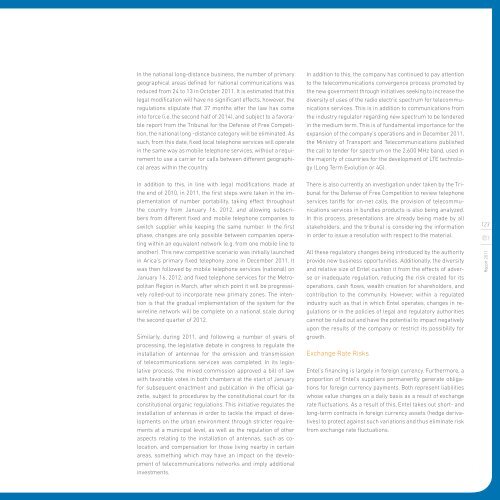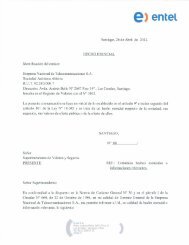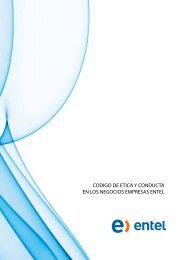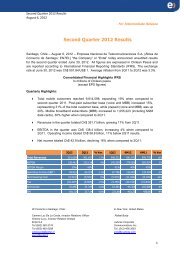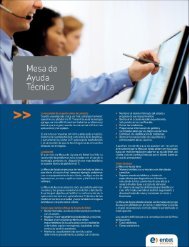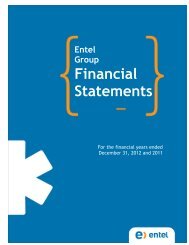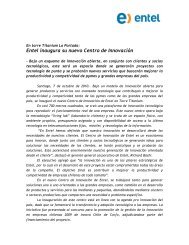In the national long-distance business, the number of primarygeographical areas defined for national communications wasreduced from 24 to 13 in October 2011. It is estimated that thislegal modification will have no significant effects, however, theregulations stipulate that 37 months after the law has comeinto force (i.e. the second half of 2014), and subject to a favorablereport from the Tribunal for the Defense of Free Competition,the national long -distance category will be eliminated. Assuch, from this date, fixed local telephone services will operatein the same way as mobile telephone services, without a requirementto use a carrier for calls between different geographicalareas within the country.In addition to this, the company has continued to pay attentionto the telecommunications convergence process promoted bythe new government through initiatives seeking to increase thediversity of uses of the radio electric spectrum for telecommunicationsservices. This is in addition to communications fromthe industry regulator regarding new spectrum to be tenderedin the medium term. This is of fundamental importance for theexpansion of the company’s operations and in December 2011,the Ministry of Transport and Telecommunications publishedthe call to tender for spectrum on the 2,600 MHz band, used inthe majority of countries for the development of LTE technology(Long Term Evolution or 4G).In addition to this, in line with legal modifications made atthe end of 2010, in 2011, the first steps were taken in the implementationof number portability, taking effect throughoutthe country from January 16, 2012, and allowing subscribersfrom different fixed and mobile telephone companies toswitch supplier while keeping the same number. In the firstphase, changes are only possible between companies operatingwithin an equivalent network (e.g. from one mobile line toanother). This new competitive scenario was initially launchedin Arica’s primary fixed telephony zone in December 2011. Itwas then followed by mobile telephone services (national) onJanuary 16, 2012, and fixed telephone services for the MetropolitanRegion in March, after which point it will be progressivelyrolled-out to incorporate new primary zones. The intentionis that the gradual implementation of the system for thewireline network will be complete on a national scale duringthe second quarter of 2012.Similarly, during 2011, and following a number of years ofprocessing, the legislative debate in congress to regulate theinstallation of antennae for the emission and transmissionof telecommunications services was completed. In its legislativeprocess, the mixed commission approved a bill of lawwith favorable votes in both chambers at the start of Januaryfor subsequent enactment and publication in the official gazette,subject to procedures by the constitutional court for itsconstitutional organic regulations. This initiative regulates theinstallation of antennas in order to tackle the impact of developmentson the urban environment through stricter requirementsat a municipal level, as well as the regulation of otheraspects relating to the installation of antennas, such as colocation,and compensation for those living nearby in certainareas, something which may have an impact on the developmentof telecommunications networks and imply additionalinvestments.There is also currently an investigation under taken by the Tribunalfor the Defense of Free Competition to review telephoneservices tariffs for on-net calls, the provision of telecommunicationsservices in bundles products is also being analyzed.In this process, presentations are already being made by allstakeholders, and the tribunal is considering the informationin order to issue a resolution with respect to the material.All these regulatory changes being introduced by the authorityprovide new business opportunities. Additionally, the diversityand relative size of <strong>Entel</strong> cushion it from the effects of adverseor inadequate regulation, reducing the risk created for itsoperations, cash flows, wealth creation for shareholders, andcontribution to the community. However, within a regulatedindustry such as that in which <strong>Entel</strong> operates, changes in regulationsor in the policies of legal and regulatory authoritiescannot be ruled out and have the potential to impact negativelyupon the results of the company or restrict its possibility forgrowth.Exchange Rate Risks<strong>Entel</strong>’s financing is largely in foreign currency. Furthermore, aproportion of <strong>Entel</strong>’s suppliers permanently generate obligationsfor foreign currency payments. Both represent liabilitieswhose value changes on a daily basis as a result of exchangerate fluctuations. As a result of this, <strong>Entel</strong> takes out short- andlong-term contracts in foreign currency assets (hedge derivatives)to protect against such variations and thus eliminate riskfrom exchange rate fluctuations.123Report 2011
Interest Rate Risks124Report 2011The company’s policy partially covers risks from interest ratefluctuations and has contracted the corresponding financialinstruments to comply with it. The proportions of variable-ratedebt exposed to fluctuations in the estimated rate behave ina manner sufficiently similar to business assets and reflectsEBITDA generated during each financial year.As of December 31, 2011, the Group had credits in foreign currencyto the value of USD $600 million, accruing interest basedon the variable Libo rate and impacting on financial expensesin the income statements. In order to mitigate the effectsof these variations, the management takes out financial contractsfor rate derivatives (Cross Currency Swap), hence fixinga significant proportion of the interest paid.When there is a rise in the Libo base rate according to marketforecasts, the Group’s annual financing costs increase,although they are still within the limits established by themanagement and the financial safeguards guaranteed to itscreditors.Credit riskCredit risk derived from the balances of accounts held withbanks, financial instruments, negotiable stocks, and derivativesis managed by the Finance Division in line with investmentcapital policies. These policies ensure the diversification ofrisk by means of pre-established limits for the duration of theplacement, percentage by institution, and the risk of instrumentsin which cash surpluses are invested. The investmentinstruments approved for use are those issued by the CentralBank of Chile or banking subsidiaries with high risk ratings.Investments may be denominated in the national currency orthe main foreign currencies.Risk exposure associated with the recovery of accounts receivableoriginating from business operations is derived from theterms of payment that must be offered as a result of the natureof the telecommunications industry to direct customers,intermediaries, and other national and international operatorswith whom reciprocal connection agreements are held.Risk management for accounts receivable is designed to minimizeexposure, insofar as possible given market conditions.Risk management processes are differentiated according todebtors’ profiles in line with segmented portfolio controls:these include consumers, enterprises, corporations, telecommunicationscompanies, correspondence, distributors, largeretailers, and other channels for the distribution of goods andservices.For each segment, there are prospective and predictive modelsthat make it possible to devise policies depending onthe origin of the debt. These range from the prepaid servicesused for the highest risk customer/product combinations, allthe way to the establishment of credit limits, with and withoutcollateral guarantees, credit insurance, and other alternatives,evaluated on a case-by-case basis.Liquidity RiskIn terms of providing the required liquidity to meet financial obligationsin a timely manner, <strong>Entel</strong> pays future expiries in advance,seeking options on the market that can provide funds in a timelymanner. As such, during 2011, the amortization installment of thesyndicated loan due in June 2012 was paid in advance, thus avoidingthe potential risks of the debt market around the due date.#
- Page 5 and 6:
Company IdentificationChairman’s
- Page 7 and 8:
Juan José Hurtado VicuñaChairmanC
- Page 9 and 10:
CONSOLIDATED REVENUEValues calculat
- Page 11 and 12:
CONSOLIDATED OPERATING INCOMEValues
- Page 14 and 15:
Chapter 1CompanyinfOrmation_
- Page 16:
KEY FIGURES 2011In CLP$ million 200
- Page 20:
1997199820002001PCS MOBILE TELEPHON
- Page 23:
Since 2009, Entel has had a Code of
- Page 26 and 27:
23Report 2011Raúl AlcaínoLihnDire
- Page 28 and 29:
New StructureIn its current organiz
- Page 30 and 31:
“workForce*_27ParentCompanyMobile
- Page 32 and 33:
72 projectswere undertaken by Human
- Page 34 and 35:
31Report 2011
- Page 36 and 37:
Entel sponsored the Sensation and C
- Page 38 and 39:
“Live better connected” Campaig
- Page 40 and 41:
Chapter 2StrategicfouNdations_
- Page 42:
Entel spentUSD $502 millionon the d
- Page 45 and 46:
custOmerserVice_42Report 2011The ma
- Page 47 and 48:
Consultancy, good practices and the
- Page 49 and 50:
innovAtion_46Report 2011Innovation
- Page 51 and 52:
48Report 2011I-factoryEntel has cre
- Page 54 and 55:
MarketSegments_Chapter 3
- Page 56 and 57:
REVENUE FOR CHILEAN TELECOMMUNICATI
- Page 58 and 59:
Connectivity Breaking Down Barriers
- Page 60 and 61:
December 5, 2011January 16, 2012Mar
- Page 62 and 63:
CONSUMERS SEGMENT SHARE OF TOTALENT
- Page 64 and 65:
945,429 subscribersMBB services (in
- Page 66 and 67:
Innovations 2011The new products an
- Page 68 and 69:
ENTERPRISE SEGMENT SHARE OF TOTALEN
- Page 70 and 71:
+50% market sharein mobile services
- Page 72 and 73:
CORPORATE SEGMENT SHARE OF TOTAL EN
- Page 74:
Mobile ServicesInfrastructureFor th
- Page 77 and 78: 15 %annual growthin Wholesale Segme
- Page 79 and 80: ...
- Page 81 and 82: pOlicy andactiOns_78Corporate socia
- Page 83 and 84: In August 2011, the second stage of
- Page 85: (* ) USD$ 45 millionParticipants in
- Page 89 and 90: (* )...consOlidatedresultS_86Report
- Page 91 and 92: mobilebUsiness_88Report 2011Market
- Page 93: wirElinebusinEss_90Report 2011Focus
- Page 96: #...
- Page 99 and 100: AmericatelpErú_96Report 2011Aligne
- Page 102 and 103: AMERICATEL PERÚ GROSS REvENUE(in U
- Page 104 and 105: (* )24%annual growthactive position
- Page 106: COPC® CertificationIn April 2011,
- Page 110 and 111: compAny andfiNancialinformation_
- Page 112 and 113: *Tax ID No. Shareholders Quantity o
- Page 114 and 115: On January 24, 2005, the board of d
- Page 116 and 117: ]q) Inversiones La Estancia II S.A.
- Page 118 and 119: :)divideNdpOlicy_The dividend polic
- Page 120: invEstmentpOlicy_The objective of t
- Page 123 and 124: sumMary oftransactiOns_Summary shar
- Page 125: iSkfactoRs_122Report 2011The Risk o
- Page 129 and 130: consolidAted materiAlevEnts 2011_12
- Page 131 and 132: 128Report 20112) Shareholding of Co
- Page 133 and 134: 130Report 2011agreement before Dece
- Page 135 and 136: (* )132Report 2011The main policies
- Page 138 and 139: ConsolidatedFinancialStatements
- Page 140 and 141: IndependentAuditor ReportIndependen
- Page 142 and 143: EMPRESA NACIONAL DE TELECOMUNICACIO
- Page 144 and 145: EMPRESA NACIONAL DE TELECOMUNICACIO
- Page 146 and 147: EMPRESA NACIONAL DE TELECOMUNICACIO
- Page 148 and 149: 2. BASIS FOR THE PREPARATION OF THE
- Page 150 and 151: 3. SUMMARY OF ACCOUNTING POLICIESa)
- Page 152 and 153: ) Transactions and Balances in Fore
- Page 156 and 157: j) GoodwillIn the case of the compl
- Page 158 and 159: Such programs include: calling cred
- Page 160 and 161: Non-Derivatives Financial Instrumen
- Page 162 and 163: CATEGORIES OF FINANCIAL ASSETS AND
- Page 164 and 165: Institution Currency DateplacementD
- Page 166 and 167: The derivatives category applies to
- Page 168 and 169: The breakdown of commercial debtors
- Page 170 and 171: 9. ACCOUNTS RECEIVABLE WITH RELATED
- Page 172 and 173: 10. INVENTORYInventory is primarily
- Page 174 and 175: Intangible assets are amortized in
- Page 176 and 177:
Transactions in 2011 for property,
- Page 178 and 179:
Components affected by impairment a
- Page 180 and 181:
c) Unrecognized Deferred Tax Assets
- Page 182 and 183:
15. OTHER FINANCIAL LIABILITIESThe
- Page 184 and 185:
CreditorClass ofLiabilityTotal debt
- Page 186 and 187:
On 12/31/2010Debtor Tax IDDebtorEnt
- Page 188 and 189:
17. OTHER PROVISIONSThe breakdown o
- Page 190 and 191:
The benefit is provided to staff th
- Page 192 and 193:
_Other reservesThe other reserves p
- Page 194 and 195:
c) Ordinary ExpenditureThe breakdow
- Page 196 and 197:
Class of asset Currency 12/31/2011T
- Page 198 and 199:
25. OPERATIONAL LEASESThe main oper
- Page 200 and 201:
General information on income, asse
- Page 202 and 203:
at the start of January for subsequ
- Page 204 and 205:
_Grupo Consultor en Telecomunicacio
- Page 207 and 208:
Current procedural stage: Ruling fo
- Page 209 and 210:
g. There are management restriction
- Page 211 and 212:
Ratio analYsis of consOlidatedfinAn
- Page 213 and 214:
Investments were mainly focused on
- Page 215 and 216:
In consideration of the aforementio
- Page 217 and 218:
consolidAtedmateriAl evEntsIn compl
- Page 219 and 220:
2) Shareholding of Coigüe in Entel
- Page 221 and 222:
IX. Parent Company - Merger by Abso
- Page 224 and 225:
sUbsidiariesand associAtecOmpanies_
- Page 226 and 227:
Entel Servicios Empresariales ( Ex
- Page 228 and 229:
Entel Servicios Empresariales (Red
- Page 230 and 231:
Subsidiaries of Entel S.A.Company N
- Page 232 and 233:
Subsidiaries of Entel S.A.Company N
- Page 234 and 235:
231Report 2011PrintingFYRMA GRÁFIC
- Page 236:
mejor Conecjor Conectado.Vivir mejo


